Introduction: An Overview of Kensett's Significance
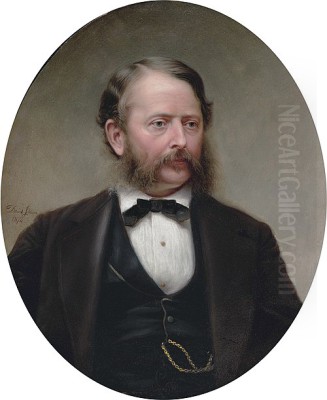
John Frederick Kensett stands as a pivotal figure in the history of American art, particularly within the flourishing landscape painting tradition of the mid-19th century. Born into a world transitioning from Neoclassicism towards Romanticism and burgeoning Realism, Kensett navigated these currents to forge a distinct artistic identity. He is celebrated as a leading member of the second generation of the Hudson River School and a key proponent, if not a definer, of the style later termed Luminism. His canvases, renowned for their serene beauty, meticulous rendering of light, and profound sense of peace, capture the essence of the American wilderness, particularly the landscapes of New England and New York. Beyond his artistic output, Kensett was an influential figure in the New York art world, contributing significantly to the establishment of major cultural institutions. His life, marked by dedication to his craft and a quiet generosity, ended tragically but left an indelible legacy on American art.
Early Life and Artistic Foundations
John Frederick Kensett was born on March 22, 1816, in Cheshire, Connecticut. Artistry was embedded in his familial roots. His father, Thomas Kensett, was an English immigrant who had established himself as a skilled engraver. Further artistic influence came from his uncle, Alfred Daggett, who also practiced the craft of engraving. This environment provided the young Kensett with his earliest exposure to the visual arts and technical training. Rather than pursuing formal academic painting studies initially, he followed the family trade, learning the meticulous techniques of engraving under the guidance of his father and uncle.
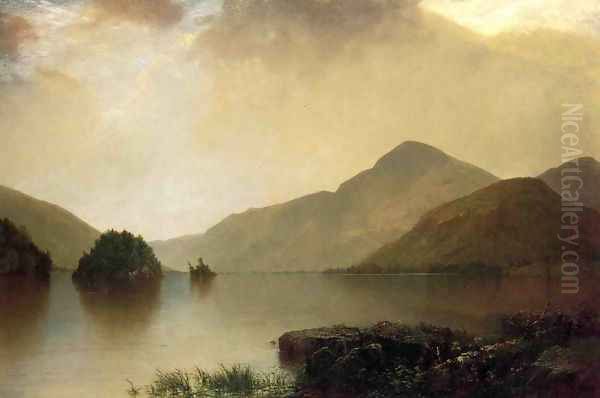
This early training in engraving proved formative. The discipline required precision, a keen eye for detail, and a mastery of line and tone – skills that would subtly inform his later painting techniques, particularly in the clarity and structure underlying his compositions. He honed these skills working in various print shops, including a significant period in New York City. During the 1830s, while primarily employed as an engraver, often working on projects like banknote vignettes which demanded exceptional control, Kensett began to explore his burgeoning interest in painting, specifically landscape painting. He started sketching outdoors and experimenting with oils, laying the groundwork for his future career.
The European Sojourn: Broadening Horizons
Recognizing the need for broader artistic exposure and study, Kensett embarked on a transformative journey to Europe in 1840. This was a common path for ambitious American artists of the era, seeking to study the Old Masters and engage with contemporary European art scenes. He did not travel alone; he was part of a cohort of American artists, including Asher B. Durand and John William Casilear, both of whom were also transitioning from engraving to landscape painting. Later, he would also associate with figures like Benjamin Champney and William S. Haseltine during his European years.
Kensett spent seven crucial years abroad, primarily in England, France, and Italy. In England, he undoubtedly absorbed the influence of landscape painters like John Constable, whose naturalistic approach and attention to atmospheric effects resonated with the developing sensibilities of American artists. In Paris, he studied paintings at the Louvre and experienced the contemporary art world. His travels through Italy exposed him to classical landscapes and the rich history of European art. However, it was perhaps the influence of 17th-century Dutch landscape painters, such as Jacob van Ruisdael and Meindert Hobbema, that proved most profound. He admired their subtle rendering of light, their carefully structured compositions, and their ability to imbue seemingly ordinary scenes with quiet dignity and mood. This period was not just about passive absorption; Kensett actively sketched and painted throughout his travels, refining his technique and developing his artistic vision. The European experience solidified his commitment to landscape painting and equipped him with a sophisticated understanding of composition, color, and light.
Return to America and Rise to Prominence
Kensett returned to the United States in 1847, his artistic skills significantly honed and his reputation already beginning to build through works sent back for exhibition. He settled in New York City, which was rapidly becoming the center of the American art world. His timing was opportune; the Hudson River School was in full swing, and there was a growing appreciation and market for American landscape painting. Kensett quickly established himself within this vibrant scene.
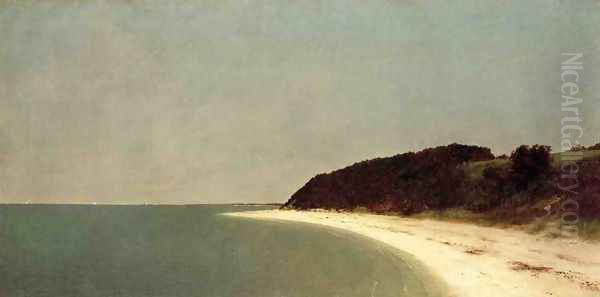
His European studies, combined with his innate sensitivity to the American landscape, allowed him to produce works that were both technically accomplished and deeply resonant with national sentiment. He was elected an Associate of the prestigious National Academy of Design in 1848, and achieved full Academician status just a year later, in 1849. This rapid recognition underscored his talent and the appeal of his work. His paintings began to sell well, attracting patronage from prominent collectors who appreciated his refined aesthetic and tranquil depictions of nature. He became a respected and well-liked member of the New York artistic community, known for his professionalism and amiable personality.
The Hudson River School Context
John Frederick Kensett is firmly situated within the Hudson River School, America's first major school of landscape painting. However, he belongs to its second generation, which emerged in the mid-19th century. While the first generation, led by figures like Thomas Cole, often favored dramatic, allegorical landscapes imbued with overt moral messages, the second generation tended towards a more naturalistic and less overtly narrative approach. Artists like Kensett, Asher B. Durand (who became a leading figure after Cole's death), Frederic Edwin Church, Sanford Robinson Gifford, and Jasper Francis Cropsey focused more on the specific effects of light and atmosphere and the detailed rendering of natural scenery.
Kensett, in particular, embraced Durand's call for artists to work directly from nature, emphasizing fidelity to observed reality. However, he filtered this reality through his own poetic sensibility. Unlike the grand, often theatrical, canvases of contemporaries like Church or Albert Bierstadt, who sought out spectacular natural wonders, Kensett often focused on more intimate, quiet scenes. His work represented a shift towards a more contemplative and less grandiose vision of the American landscape, emphasizing harmony and tranquility over untamed wilderness or sublime drama. He found beauty in the gentle hills, serene lakes, and rocky coastlines of the Northeast, rendering them with a characteristic calm and clarity.
Development of a Signature Style: Luminism
Kensett's mature style is most closely associated with Luminism, a term coined by later art historians to describe a particular mode of American landscape painting prevalent from the 1850s to the 1870s. While not a formal movement with a manifesto, Luminism is characterized by its focus on light and atmosphere, often rendered with invisible brushwork, creating smooth, polished surfaces. Luminist paintings typically feature calm, reflective water, hazy skies, and a pervasive sense of stillness and silence. The light itself often seems to be the true subject, evoking a spiritual or transcendental quality in nature.
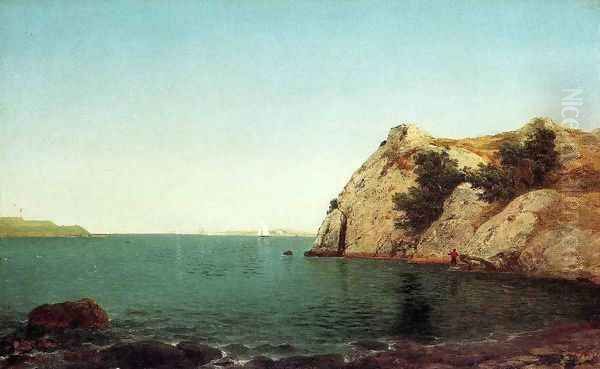
Kensett, alongside artists such as Fitz Henry Lane, Martin Johnson Heade, and Sanford Robinson Gifford, was a leading practitioner of this style. His work evolved from the more detailed, picturesque style influenced by Durand towards a greater simplification of form and an intensified focus on atmospheric effects. He became a master of depicting the subtle gradations of light at different times of day, particularly the soft glow of dawn or the hazy stillness of midday. His compositions often feature strong horizontal elements – shorelines, horizons, calm water – which contribute to the sense of stability and peace. The human presence, if included at all, is usually minimal, dwarfed by the scale and serenity of nature. Kensett's Luminism was not just a technical exercise; it was a means of expressing a deeply felt connection to the spiritual tranquility he perceived in the natural world.
Mastering Light and Atmosphere
The defining characteristic of Kensett's art is his extraordinary sensitivity to light and atmosphere. He possessed a remarkable ability to capture the specific quality of light – whether the crisp, clear air of an autumn day, the humid haze of summer, or the soft, diffused light filtering through clouds over water. This was achieved through meticulous technique and careful observation. His brushwork, particularly in his mature works, became increasingly refined, often leaving little or no visible texture on the canvas surface. This smoothness enhances the sense of stillness and allows the subtle shifts in tone and color to dominate.
Kensett employed a sophisticated, often restrained, color palette. While capable of capturing brilliant sunsets, he frequently favored cooler tones – blues, grays, greens, and silvery whites – especially in his coastal scenes. He masterfully handled tonal gradations, creating a seamless transition between water, land, and sky. This tonal control is crucial to the Luminist effect, contributing to the sense of depth, airiness, and pervasive light. His compositions are typically characterized by a sense of balance and order, often using a stable structure of horizontal bands counterbalanced by subtle diagonals or vertical elements like trees or rocks. This underlying geometry provides a sense of calm permanence, reinforcing the tranquil mood of his landscapes.
Iconic Landscapes: Subject Matter and Key Works
Kensett found his primary inspiration in the landscapes of the American Northeast, particularly New York State and New England. He traveled extensively throughout these regions, sketching outdoors during the summer months and developing larger canvases in his New York studio during the winter. His favored subjects included the Catskill Mountains, the Adirondacks, the White Mountains of New Hampshire, the shores of Lake George, and the coastlines of Connecticut, Rhode Island (especially Newport), and Massachusetts.
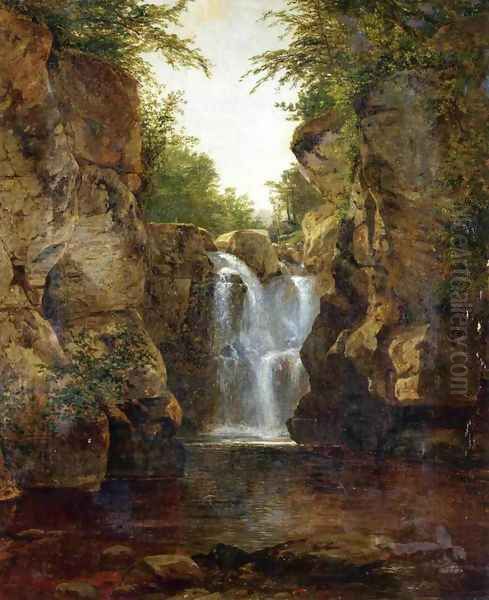
Among his most celebrated works is Lake George (painted in several versions, a notable one dated 1869 is in The Metropolitan Museum of Art). These paintings capture the serene beauty of the lake, often depicted under a calm, luminous sky, with distant mountains rendered in soft, atmospheric tones. The reflective surface of the water plays a crucial role, mirroring the sky and enhancing the sense of tranquility and perfect harmony.
Another iconic work is Eaton's Neck, Long Island (c. 1872, The Metropolitan Museum of Art). Considered one of his final masterpieces, it exemplifies his late Luminist style. The composition is radically simplified, dominated by horizontal bands of sand, sea, and sky. The light is palpable, suffusing the scene with a quiet, almost ethereal glow. The brushwork is virtually invisible, creating a smooth, glassy surface that enhances the stillness.
Beacon Rock, Newport Harbor (1857, National Gallery of Art) showcases his skill in depicting coastal scenes. The painting balances the solidity of the foreground rocks with the expansive, light-filled sky and calm water. It demonstrates his ability to combine detailed observation of geological forms with a broader atmospheric sensitivity, capturing the unique light and air of the Newport coast.
Mount Washington from the Valley of Conway (1851, Davis Museum at Wellesley College) represents his earlier, more detailed Hudson River School style, yet still shows his characteristic sensitivity to light and atmosphere in the rendering of the majestic mountain landscape. Other important works like Bash Bish Falls (c. 1855) and various coastal views further demonstrate his range and mastery within the landscape genre. These works, consistently praised for their poetic beauty and technical refinement, secured Kensett's reputation as one of America's foremost landscape painters.
Western Journeys
While best known for his depictions of the Northeast, Kensett, like many of his contemporaries, also traveled west, seeking new landscapes and experiences. In 1857, he journeyed along the Mississippi River. Later, in 1870, he joined a survey expedition that took him to Colorado. This trip provided him with sketches of the Rocky Mountains, a dramatically different landscape from his usual subjects.
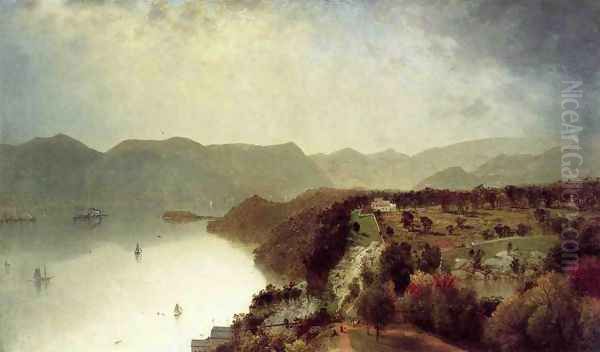
One notable work resulting from this trip is Snowy Range and Foothills from the Valley of the Cache la Poudre, Colorado (1870, Denver Art Museum). While retaining his characteristic clarity and attention to light, this painting tackles the grander scale and different atmospheric conditions of the West. Although his Western views form a smaller part of his overall output compared to artists like Bierstadt or Thomas Moran, they demonstrate his versatility and his engagement with the broader national project of exploring and depicting the American continent. These journeys reflect the expansionist spirit of the era and the desire of artists to capture the diverse beauty of the nation.
Relationships with Contemporaries
Kensett was an active and respected member of the New York art community, maintaining relationships with many leading artists of his day. His European travels alongside Asher B. Durand and John William Casilear fostered close ties. He deeply respected Durand, whose emphasis on direct observation from nature significantly influenced Kensett's own practice, even though Kensett developed a more refined and less rugged style.
His relationship with Thomas Cole, the founder of the Hudson River School, was perhaps more complex. While acknowledging Cole's importance, Kensett's artistic temperament leaned away from Cole's dramatic allegories and towards Durand's quieter naturalism. He shared stylistic affinities with fellow Luminists like Fitz Henry Lane, Martin Johnson Heade, and Sanford Robinson Gifford, exploring similar themes of light, stillness, and coastal scenery, though each maintained a distinct artistic personality.
He was also a contemporary of the great panoramic landscape painters Frederic Edwin Church and Albert Bierstadt. While Kensett's work generally lacked the overt drama and monumental scale favored by Church and Bierstadt, he was part of the same artistic milieu and shared in the general public enthusiasm for landscape painting. He maintained friendships and professional associations with a wide circle of artists, including Jervis McEntee and Worthington Whittredge. His generally amiable nature and professional success made him a central figure in the artistic life of New York.
Beyond the Easel: Institutional Roles and Social Contributions
Kensett's influence extended beyond his own artistic production. He was deeply committed to building the infrastructure of the American art world. His early election to the National Academy of Design was just the beginning of his institutional involvement. He was an active member, participating in exhibitions and serving on committees.
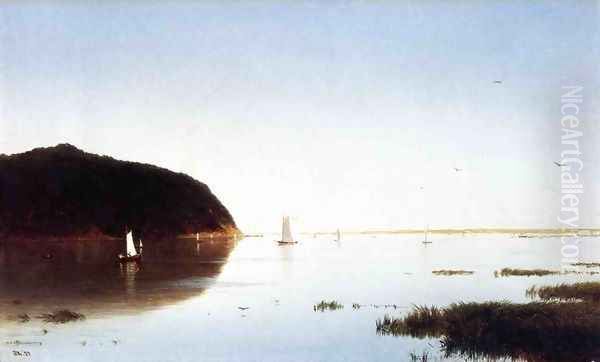
He was also a founding member of the Artists' Fund Society, established in 1859 to provide financial assistance to artists in need and their families. This reflects his sense of community and concern for the welfare of his fellow artists. Perhaps his most significant institutional contribution was his role in the founding of The Metropolitan Museum of Art in 1870. He was not only one of the incorporators but also served as a trustee and a member of the art committee, helping to shape the early direction and collections of what would become one of the world's leading museums.
Kensett also engaged in broader civic activities. He was appointed by Congress to a commission overseeing the artistic decoration of the United States Capitol building in Washington, D.C. During the Civil War, he actively supported the Union cause, notably contributing works to the fundraising efforts of the United States Sanitary Commission, particularly the large New York Sanitary Fair of 1864. His reputation for integrity and generosity was well-known among his peers and patrons.
A Tragic End and Lasting Legacy
John Frederick Kensett's life came to a sudden and tragic end in December 1872. In November of that year, while at his home on Contentment Island, near Darien, Connecticut, he reportedly attempted to retrieve the body of his cousin's wife, Mary Lydia (Hancock) Colyer (often misidentified as Mrs. Vincent), who had drowned in Long Island Sound. He spent considerable time in the icy water during the attempt. Shortly thereafter, he contracted pneumonia. His weakened condition, possibly exacerbated by an underlying heart condition, led to his death in his New York City studio on December 14, 1872, at the age of 56.
His death was widely mourned in the art world and beyond. He was remembered not only as a brilliant artist but also as a gentleman of great character and generosity. His legacy was immediately secured. In an act of profound generosity that cemented Kensett's connection to The Metropolitan Museum of Art, his brother, Thomas Kensett, donated a large collection of his paintings and studies – essentially the contents of his studio – to the fledgling museum in 1874. This collection, known as the Kensett Papers and Paintings, remains a cornerstone of the museum's American Wing and provides invaluable insight into his working methods and artistic development.
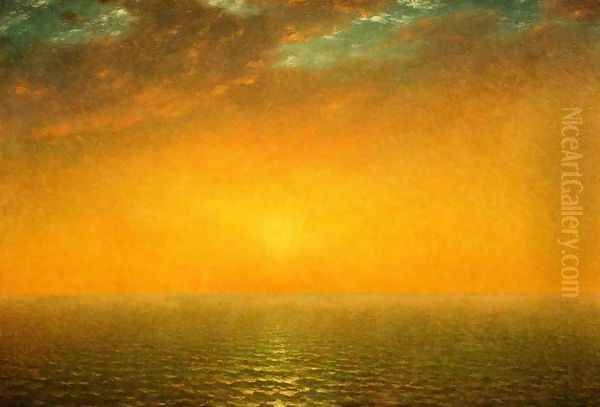
Today, Kensett's works are held in major museums across the United States, including the National Gallery of Art in Washington, D.C., the Museum of Fine Arts, Boston, the Wadsworth Atheneum in Hartford, the Art Institute of Chicago, and many others, in addition to The Met. He is consistently recognized as a key figure in 19th-century American art, a master of the Hudson River School, and a quintessential Luminist painter. His ability to capture the quiet beauty and transcendent light of the American landscape continues to resonate with viewers, offering moments of peace and contemplation.
Conclusion: The Enduring Appeal of Kensett's Vision
John Frederick Kensett carved a unique path through the landscape of 19th-century American art. Starting with the meticulous craft of engraving, he blossomed into a landscape painter of exceptional sensitivity and skill. As a leading figure of the Hudson River School's second generation and a master of Luminism, he translated his deep appreciation for the natural world into canvases imbued with tranquility, order, and an almost spiritual quality of light. His depictions of the serene lakes, hazy mountains, and luminous coastlines of the Northeast offer a vision of nature as a source of peace and quiet harmony. Beyond his artistic achievements, his dedication to fostering artistic institutions like the National Academy of Design and The Metropolitan Museum of Art, and his personal integrity, solidified his importance. Though his life was cut short, Kensett's legacy endures through his beautiful paintings, which continue to captivate audiences with their subtle mastery and timeless evocation of light and stillness.